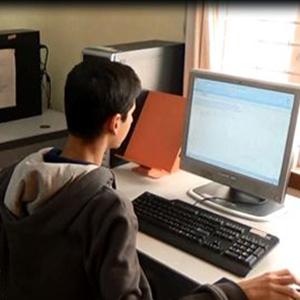
International Autism Awareness Day 2016 #autismawareness
Kavita Sharma talks about Prayas, a unit or a project of Autism Society of India that focuses on iPad, computer and technology-based training for individuals with Autism Spectrum Disorder.
Could you give us a little background on Project Prayas and its goals and objectives?
Project Prayas embraces a mission that unfolds and reinforces the potentials of individuals with Autism Spectrum Disorder towards quality education and independent livelihood. This mission is intended to be achieved with the help of technology at the early intervention level.
We, at Prayas, follow a simple model of training where parent empowerment is the key to success. Our method of training involves an amalgamation of special educational techniques and technology. We also believe in giving a well-designed environment to the individual with autism where all the issues related to sensory defensiveness are worked upon.
Your first workshop conducted in 2011 focussed on pioneering the use of iPads to interact with children with autism. What was the outcome and how was the programme evaluated?
The iPad Workshop, which was conducted in March 2011, was an eye opener for us as we could witness the ease with which kids with autism got on with gadgets even on first exposure. We did not have any evaluation criteria then, as, all of us were new to iPads. All we could observe was the ‘PIN DROP SILENCE AND HAPPINESS’ when kids were given iPads.
You have also set-up a computer lab in association with Autism Society of India. What is its purpose?
The purpose of setting up this computer lab was to explore the avenues of learning other than the traditional methods. By this time, we had also been hearing about the work of Specialisterne, Denmark, on exploring the avenues of employment that technology can offer -- this gave us further hope to work towards the same cause.
How does technology help in integration of children with autism? Or bettering their lives?
I see an equation between technology and the modalities of learning of persons affected with autism, as
• It offers order in learning- ORDER IS THE REGIME
• It follows a medium of visuals, graphics and sounds- LOVE VISUALS
• It offers predictability
• Applications can be used repeatedly to strengthen learning.
• It is a non-judgemental and non-threatening tool, and it helps in dealing with issues related to Sensory Defensiveness
Now, to look at providing quality of life, we have been able to discover the unique potential of persons with ASD and equated these with technology. For example:
• Attention to detail- Software Testing
• Photographic memory- Reproducing facts
• Association to events, facts etc- Learn to code
• Love to follow order or structure- Accurate outcomes
• Learning in real life situation- Hands on training/observation opportunity
• Repetition-use in bringing perfection
• Unerring focus- Completion of tasks on time
• Pattern recognition- Finding flaws and errors
• Openness and Truthfulness- Work till perfection is achieved
The quality of life can also be seen from the point of view of independent living, as the mobile goods offer so many apps which are needed for day to day living.
If individuals with Autism become computer literate or get savvy with gadgets, does it improve their employment prospective? What jobs can they be employed for?
Digitization and Data Entry are the simpler tasks for any individual. Prayas has augmented its focus to others areas as well, like Testing, Coding and Designing.
Testing Software may be a skill with repetition, but it is a high-end skill requiring precision. Thirteen people diagnosed with Autism Spectrum Disorders are employed at SAP in this task in a completely OPEN employment situation.
Software testing involves:
- Repetitive test execution
- Scrutiny of changes in application
- Repetition of tests in multiple systems, devices etc
- Transparent reporting of issues/status
- High volume manual tests due to limited automation support/benefits
What becomes a challenge and monotony for regular testers over time can be managed with testers who have autism because they are strong on observation, repetition and openness.
Digital Designing also seems to be an avenue to explore the possibilities of employment in terms of OPEN, SUPPORTED, SHELTERED and SELF.
Prayas aims to bring awareness of these avenues with respect to the applicability by developing skills and being a part of a product.
See the video on Prayas below
How many children have completed the training at Project Prayas? How many people have then been employed and with which organisations?
At Prayas, through our ten batches, we have been able to train around 120 individuals with autism. At SAP Bangalore, 13 employees with autism have been employed.
And over 100 across SAP worldwide https://twitter.com/vrferose/status/712718667218337792
The other organisations in India who have hired persons with autism are Accenture and Allegis.
Related article: Why companies are hiring people with autism
What are the key drivers of success to make organisations inclusive?
Inclusion of persons with autism is possible in the families, schools, societies and work places only if all involved decide to collaborate and work with each other.
I state this on a strong note as 95% of persons with autism do not speak for themselves. Somewhere parents play a key role and this has to be recognised by the authorities in schools, communities, companies and corporates.
An ecosystem needs to be in place with respect to proper education, training, placement and retention for the person with autism and a constant orientation for the other employees, giving incentives to them to work as a mentor, giving rewards and recognition to the mentor and the mentee (Autism Affected) in order to drive inclusion at work place.
Related articles on Autism
Mentoring and Empowering Young Adults
Children with Autism benefit from a theatre based program
What is your message to parents of children with autism and to organisations on Autism Awareness Day?
Lots of hard work is needed from the parents’ side. They should accept the condition and work on it continuously. If we can leave aside the causes and co-morbid conditions, parents need to focus on the issues of Sensory Overload of environmental stimuli. They need to understand that the reactive responses to these stimuli are not Problem Behaviours and one can manage them only if we prevent Sensory Overload by optimising the environmental stimuli. So,
- Speak softly,
- Avoid Perfumes,
- Have a smooth work floor,
- Work on Body Awareness,
- Identify the taste buds of your child,
- Get to know the requirement of touch!
Use our OER (Open Educational Resources): www.learn4autism.com
Other than the parents, the Government of India has to include Autism in the PWD Act of 1995. It has not been passed in the Houses Parliament and it is still in the draft phase, now called RPWD ACT 20154. Once this bill becomes an act, we can have correct policies in place and have headway to success.
For parents, lots of workshops on awareness about the avenues technology offers should be arranged. Affordability of the equipment, devices and software, accessibility options of internet need to be focussed on with a long term outcome of a productive citizen in mind.
Organisations like schools, training centres and corporates need to look at the potentials of persons with autism and work on those by adding adaptations and accommodations.
After all, all of us like good learning and working conditions.







